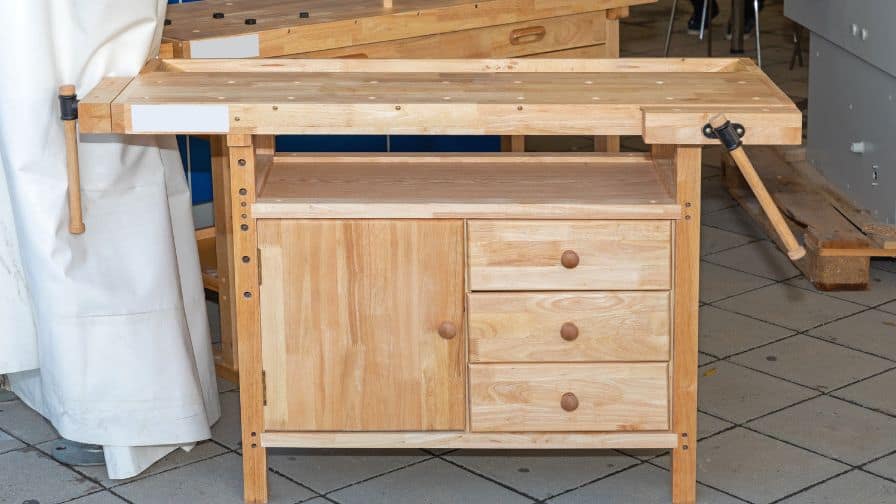
There are a few options when it comes to finishing a pine workbench.
In this blog post, we will discuss the best finish for pine wood and why. We will also provide tips on how to apply the finish correctly. When you are looking to give your pine workbench a beautiful finish, then read on!
Best Finish For Pine Workbench
The best finish for a pine workbench is a Danish oil finish. This type of finish will protect the wood from moisture and wear, while still allowing the wood to breathe. It is important to apply several coats of Danish oil, letting each coat dry completely before applying the next. Once the final coat has been applied, you can then wax the bench top for additional protection.
When it comes to choosing the best finish for a pine workbench, there are a few things to keep in mind. The first is that pine is a fairly soft wood, so it is important to choose a finish that will protect it from scratches and wear. Danish oil is a great option for this, as it will both protect the wood and allow it to breathe. Another thing to keep in mind is that pine is a very absorbent wood, so it is important to apply several coats of finish. This will ensure that the finish lasts for many years to come.
What Are The Different Finishes That You Can Use On Pine Wood?
There are four main finishes that you can use on pine wood: paint, stain, varnish, and polyurethane. Each has its benefits and drawbacks that you should consider before deciding which one is right for your project.
Paint is the most versatile finish and can create any look you want. It’s also the most durable, making it a good choice for high-traffic areas or pieces that are subject to wear and tear. The downside is that paint can get tricky to apply evenly, and it takes longer to dry than other finishes.
Stain is a popular choice for furniture and trim because it highlights the wood’s grain and natural beauty. It’s also easy to apply and quick to dry. The downside is that stain can get difficult to touch up, and it doesn’t offer much protection from scratches.
Varnish is a durable finish that offers good protection from scratches. It’s also resistant to stains and easy to clean. The downside is that varnish can yellow over time.
Polyurethane is the most durable finish and offers good protection from scratches and wear. Like varnish, it fights stains and is simple to clean. The downside is that polyurethane can also yellow over time.
How Do You Apply A Finish To Pine Wood Correctly?
Subscribe to DIY Montreal
Pine is a beautiful wood that can finish nicely. But only when you apply the right products and follow the proper steps.
Here are the basics of how to finish pine wood correctly:
First, you need to sand the pine wood thoroughly. You should use progressively finer grits of sandpaper until the surface is smooth.
Next, apply a sealer to the pine wood. This will help protect it from moisture and other damage.
Finally, put a finish on the pine wood. This can range from paint to stain. Make sure you choose a finish that is compatible with the sealer you used.
By following these steps, you can create a beautiful finish on your pine wood surfaces. Have patience and take your time to get the best results.
Should I Seal My Pine Workbench Top?
Yes. A coat of sealer will not only protect your bench top from spills and stains, but it will also give it a nice sheen. Plus, it’ll make cleanup a breeze. Use a good-quality sealer designed for indoor use. Apply several thin coats, rather than one thick coat. That way, the finish will last longer. Let each coat dry completely before applying the next.
Sealing your pine workbench top is a great way to protect it and keep it looking its best! Follow these tips and you’re sure to get satisfactory results!
Should I Stain My Pine Workbench
Staining your pine workbench top is a fabulous way to protect it from damage and give it a unique look!
Here are some things to keep in mind when deciding whether or not to stain your pine workbench top:
-The type of stain you use will affect the color of your workbench top.
-Staining your workbench top will give it a more finished look.
-The amount of stain you use will determine how dark or light the color of your workbench top will appear.
-You can always test the stain on a small area of the workbench top to see how it will look before you commit to staining the entire thing.
So, what do you think? Should you stain your pine workbench top? I say go for it! Stains can enhance the look of your workbench and help it to last longer. Plus, it’s a fun project to tackle!
How To Protect A Pine Workbench Top
Subscribe to Caleb’s Shop
To keep your workbench top looking new, follow these tips.
First, always use a clean cloth when wiping up any liquid or debris.
Second, when you need to sand the surface for any reason, use fine-grit sandpaper and sand in the direction of the wood grain.
Third, as you spill any oil-based products on the bench top, clean it up immediately with a rag and some mineral spirits.
Fourth, to protect the surface from scratches, always use coasters or mats under any tools or materials you place on the workbench.
By following these tips, you can keep your pine workbench top looking new for years to come.



